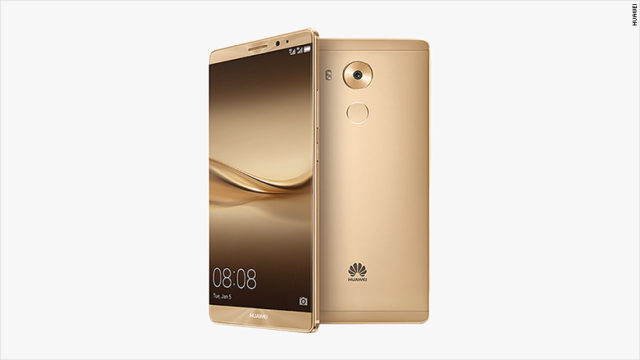LAS VEGAS- A low-cost “budget” television company unveils a high-end offering rivaling the industry leaders. One of the world’s largest smartphone makers develops a new way to tap the screen. Another smartphone company produces innovation for less than $115 per device.
All of these breakthroughs were announced Tuesday by companies at CES in Las Vegas. And in every case, the company is headquartered in China.
Huawei
First up, Huawei. It unveiled two new smartphones, a tablet and even a watch. Each of them offers new twists on what consumers have come to expect. From using knuckles for on-screen gestures to a mode that lets the user screenshot an entire webpage, Huawei drew more than a few “oohs” from the capacity crowd.
#Huawei introduces Mate8#CES2016 claims 2.36 days battlife,30min charge,fingerprint rear selfiebutton @CCTV_America pic.twitter.com/YeR9fH3gQu
— Mark Niu (@MarkNiuWrite) January 5, 2016
Use your knuckles for cropping, capturing and recording #Huawei #Mate8 #CES2016 pic.twitter.com/RmULMgszJF
— Huawei Device (@HuaweiDevice) January 5, 2016
The attendance at this @Huawei event may be among the biggest at #CES2016 so far. pic.twitter.com/G23DCBiOeO
— CCTV America (@CCTV_America) January 5, 2016
Huawei is already the world’s third largest smartphone maker, having surpassed Microsoft last year. In its presentation to the media Tuesday at CES, the company said it will soon become the second-largest globally. To do that, it will have to secure more market share than the mighty Apple (and be second only to Samsung).
TCL
The budget-friendly television manufacturer TCL debuted its high-end QUHD line Tuesday, including the stunning TCL X1. It has powerful speakers designed by Harmon Kardon, as well as a visual display with Dolby technology. That’s on top of TCL’s newly-revealed 4K models, which run on a Roku platform to make streaming content a breeze.
The speakers from this @TCL_USA TV are so powerful, it just filled the conference room with rich sound. #CES2016 pic.twitter.com/dr2oFJ2CFh
— CCTV America (@CCTV_America) January 5, 2016
Even before these announcements, TCL is already one of the fastest growing television brands in the United States.
ZTE
Staying true to its budget-friendly roots, ZTE unveiled two Android smartphones for the U.S. market. The more expensive device is the “Grand X3”. It’s priced at $129.99 and features an HD (though only 720p) display, 16GB of storage and an 8-megapixel camera. While even the company admits these are not trailblazing specifications, it says this is the affordable phone that consumers “deserve.”
Within 2 minutes of taking the stage, @ZTE_USA already makes its first reveal. "Grand X 3" ($129 at Cricket) pic.twitter.com/3OvMLbJbBg
— Matt Simon (@MSimonTV) January 5, 2016
Those aren’t the only Chinese companies in the spotlight at CES.
Hisense
There’s also Hisense, which is now going to sell a series of televisions under the Sharp branding. The company also announced some ambitious goals for expansion in the U.S. market, including the pledge to be the third largest brand in the U.S. by 2019 (right now, it’s number 8).
We have heard of glasses-free television. Now @Hisense_USA unveils panel-free television. #CES2016 #lasers pic.twitter.com/ZBqnTy0edR
— CCTV America (@CCTV_America) January 5, 2016
Get set for 22 new models from @Hisense_USA in 2016. Some integrate with @RokuPlayer (like @TCL_USA). #CES2016 pic.twitter.com/zEsJQAavrX
— CCTV America (@CCTV_America) January 5, 2016
Those are just the companies based in China.
Faraday Future (or “FF”)
Faraday Future may have made the biggest announcement of the year at CES with its debut of the concept FFZERO1 car. It has major backing from Chinese entrepreneurs.
So what are the potential pitfalls?
Several industry observers in Las Vegas told CCTV-America that U.S. consumers are still wary of Chinese technology, mainly because of quality concerns. (To that end, ZTE announced an “unlimited repairs” program and Hisense announced a 4-year warranty on its 4K televisions.)
.@ZTE_USA unveils a program called "Passport 2.0," with unlimited repairs (among other things) #CES2016 pic.twitter.com/lDkCivV6DE
— CCTV America (@CCTV_America) January 5, 2016
There are also concerns about buggy software performance, as with the Huawei devices. (And that’s part of the reason for TCL relying so heavily on the trusted and beloved Roku platform.)
The introduction– and expansion– of Chinese technology in the West is not only shifting price points downward. It’s also positioning Chinese companies to be one of the potential success stories in the decade ahead. Indeed, many would argue that these companies have already exceeded expectations. What remains to be seen is to what degree these companies innovate to create new technologies, and not just drive prices lower on already-existing technologies.
 CGTN America
CGTN America

